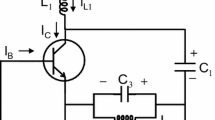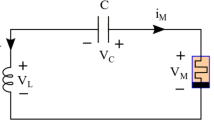Abstract
This research paper reports a novel design for third order chaotic and hyperchaotic oscillator with cubic nonlinearity using single operational trans-resistance amplifier (OTRA) and few passive elements. The key nonlinear dynamical characteristics in terms of sensitivity, divergence, equilibrium point and Lyapunov exponent are recorded in this literature. The operational activity of the proposed oscillator based on OTRA is integrated using 0.25 µm TSMC CMOS parameter. For the generation of hyperchaotic oscillator, an external capacitor is added to the third order chaotic oscillator. To justify the theoretical nonlinear dynamics of proposed chaotic oscillator, PSPICE simulation by using CMOS based OTRA and experimental investigation using IC AD844 based OTRA are well implemented.


















Similar content being viewed by others

References
Strogatz, S. H. (2014). Nonlinear dynamics and chaos: With applications to physics (2nd ed.). New York: Hachette Book Group.
Banerjee, S. (2010). Chaos synchronization and cryptography for secure communications. In S. Banerjee (Ed.), Applications for encryption. Hershey: IGI Global.
Chua, L. O., Wu, C. W., Huang, A., et al. (1993). A universal circuit for studying and generating chaos. I. Routes to chaos. IEEE Transactions on Circuits and System I: Fundamental Theory and Applications,40(10), 732–744.
Sprott, J. C. (2011). A new chaotic jerk circuit. IEEE Transactions on Circuits and Systems II: Express Briefs,58(4), 240–243.
Toumazou, C., Lidgey, F. J., & Haigh, D. G. (1990). Analogue IC design: The current-mode approach. London: Peter Peregrinus Ltd.
Ferri, G., & Guerrini, N. C. (2003). Low-voltage low-power CMOS current conveyors (1st ed.). London: Kluwer Academic Publishers.
Tamaseviius, A., Lindberg, E., & Kirvaitis, R. (2009). Autonomous Duffing–Holmes type chaotic oscillator. Elektronika ir Elektrotechnika,5, 43–46.
Silva, C. R., & Young, A. M. (1998). Implementing RF broadband chaotic oscillators: Design issues and results. In IEEE international symposium on proceedings of the circuits and systems, Monterey, CA (Vol. 4, pp. 489–493).
Tamaseviciute, E., Tamasevicius, A., et al. (2008). Analogue electrical circuit for simulation of the Duffing–Holmes equation. Nonlinear Analysis: Modelling and Control,13(2), 241–252.
Kennedy, M. P. (1992). Robust OP Amp realization of Chua’s circuit. Frequenz,46(1992), 3–4.
Elwakil, A. S., & Kennedy, M. P. (2000). Improved implementation of Chua’s chaotic oscillator using current feedback Op Amp. IEEE Transactions on Circuits and Systems,47(1), 76–79.
Pandey, N., & Pandey R. (2013). Current mode full-wave rectifier based on a single MZC–CDTA. In Active and passive electronic components, 2013.
Kumar, A., & Paul, S. K. (2018). Nth order current mode universal filter using MOCCCIIs. Analog Integrated Circuits and Signal Processing,95, 181.
Ranjan, R., & Paul, S. K. (2018). CMOS based sinusoidal oscillator using single CCDDCCTA. Analog Integrated Circuits and Signal Processing,94, 177–193.
Ranjan, A., et al. (2018). A novel Schmitt trigger and its application using a single four terminal floating nullor (FTFN). Analog Integrated Circuits and Signal Processing,96(7), 455–467.
Gandhi, G. (2006). Improved chua is circuit and its use in hyper chaotic circuit. Analog Integrated Circuit and Signal Processing,46(2), 173–178.
Kushwaha, A. K., & Paul, S. K. (2016). Chua’s oscillator using operational transresistance amplifier. Revue Roumaine des Sciences Techniques-Serie Electrotechnique et Energetique,61, 299–303.
Kushwaha, A. K., & Paul, S. K. (2016). Inductorless realization of Chua’s oscillator using DVCCTA. Analog Integrated Circuit and Signal Processing,88, 137–150.
Kennedy, M. P., et al. (2005). A fast and simple implementation of Chua’s oscillator with cubic-like Nonlinearity. International Journal of Bifurcation and Chaos,15, 1394–1410.
Piper, J. R., & Sprott, J. C. (2010). Simple autonomous chaotic circuits. IEEE Transactions on Circuits and Systems—II: Express Briefs,57(9), 730–734.
Tchitnga, R., et al. (2016). Chaos in a single Op-Amp-based jerk circuit: Experiments and simulations. IEEE Transactions on Circuits and Systems II: Fundamental Theory and Applications,63(3), 239–243.
Liu, J., et al. (2018). An approach for the generation of an nth-order chaotic system with hyperbolic sine. Entropy,20, 230.
Chunbiao, L., & Sprott, J. C. (2014). Coexisting hidden attractors in a 4-D simplified Lorenz system. International Journal of Bifurcation and Chaos,24(3), 1450034.
Lorenz, E. N. (1963). Deterministic non-periodic flow simple 4D chaotic oscillator. Journal of Atmospheric Sciences,20, 130–141.
Mostafa, H., & Soliman, A. M. (2006). A modified realization of the OTRA. Frequenz,60, 70–76.
Pandey, R., Pandey, N., & Paul S. K. (2014). Signal processing and generating circuits using OTRA as a building block. Retrieved December 23, 2014 from http://shodhganga.inflibnet.ac.in/handle/10603/31644.
Zhou, W., Xu, Y., et al. (2008). On dynamics analysis of a new chaotic attractor. Physics Letters,372(36), 5773–5777.
Jinhu, L., Chen, G., & Zhang, S. (2002). Dynamical analysis of a new chaotic attractor. International Journal of Bifurcation and Chaos,12(2), 1001–1015.
Nagar, B. C., & Paul, S. K. (2018). Dynamical single OTRA based two-quadrant analog voltage divider. Analog Integrated Circuit and Signal Processing,94, 161–169.
Author information
Authors and Affiliations
Corresponding author
Rights and permissions
About this article
Cite this article
Joshi, M., Ranjan, A. An autonomous chaotic and hyperchaotic oscillator using OTRA. Analog Integr Circ Sig Process 101, 401–413 (2019). https://doi.org/10.1007/s10470-019-01395-0
Received:
Revised:
Accepted:
Published:
Issue Date:
DOI: https://doi.org/10.1007/s10470-019-01395-0



